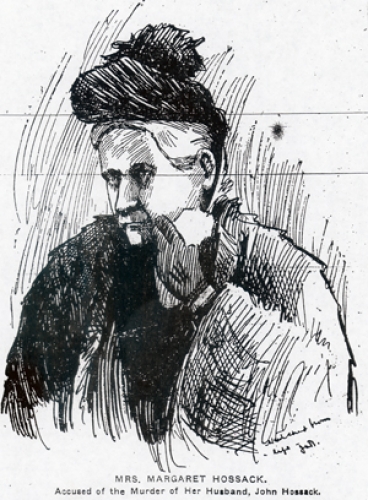Midnight Assassin: A Murder in America’s Heartland. By Patricia Bryan and Thomas Wolf. Algonquin Books of Chapel Hill, 278 pages, $23.95.
On a December night in 1900, in the small community of Warren County, Iowa, someone entered the bedroom of John Hossack, and as the fifty-nine-year-old father of nine slept, struck him twice in the head with an ax. Ten hours later, Hossack died. A local newspaper described the cause of the farmer’s death as “having his brains beaten out.”
In 1998, almost a century after the murder, another Warren County newspaper ran a bold headline for an advertisement that read: “Who Killed John Hossack?” Those who might have answers were asked to contact Patricia Bryan, professor of law at UNC-Chapel Hill.
More than a dozen people responded to the ad, and Bryan interviewed one local lawyer who warned: “You might be in danger if you get too close to the truth.”
Despite the warning, Bryan persisted in her quest to solve the little-known murder. It was a quest that started with a work of fiction.
Long before there was Court TV, there was Susan Glaspell’s “A Jury of Her Peers,” a short story about a woman accused of the murder of her husband. Bryan had often wondered what inspired Glaspell to write the story and raise questions about whether a woman in the early twentieth century could be fairly judged in a courtroom controlled by men.
So one day, Bryan says, after a “spirited debate” over the story in her law and literature seminar, Bryan “decided to play detective.”
Bryan started with Glaspell’s memoir.
In her memoir, Glaspell claimed a real-life murder investigation she covered while a newspaper reporter inspired “A Jury of Her Peers.” But the Pulitzer Prize winner revealed no other details.
Bryan traced Glaspell’s newspaper career back to the Des Moines Daily News.
The first major story Glaspell covered for the Iowan newspaper? The investigation of John Hossack’s death and the murder trial of his wife, Margaret.
Moments after the funeral of John Hossack, a sheriff arrested Hossack’s wife as she walked away from the burial ground. Prosecutors charged her with first-degree murder and argued that the testimony of neighbors revealed the motive: after years of living with a husband who verbally abused and threatened her and her children, Margaret Hossack snapped.
The fifty-seven-year-old farmwife pleaded her innocence, denied her husband’s abuse, and claimed she had been asleep — beside her husband, in the same bed — when an unknown intruder bludgeoned him. All nine of her children supported her during two trials.
A jury — of twelve men — found her guilty during the first trial, and she was sentenced to life in prison. Hossack, described by Glaspell as having “a bulldog tenacity,” spent a year in the Anamosa State Penitentiary before the Iowa Supreme Court threw out the verdict on appeal. A second jury — also of twelve men — could not reach a verdict. Hossack was released from prison and lived the remaining fifteen years of her life in the same small community where she raised her children.
But Margaret Hossack’s guilt remained a matter of dispute, Bryan says.
Even in the late 1990s, when Bryan first visited Warren County to research the Hossack case, she discovered that “The murder, after all these years, had not been forgotten,” she says.
Bryan interviewed one resident, for example, who warned that “old ghosts should not be disturbed,” while another resident wanted “the truth to come out.”
In an attempt to solve the cold case, Bryan inspected newspaper articles, legal briefs, probate records, and transcripts from the grand jury hearings and trials; conducted numerous interviews with Warren County residents and descendants of the Hossack family; and listened to taped recordings of private memoirs.
Bryan, along with her husband and writer Thomas Wolf, laid out the findings in Midnight Assassin: A Murder in America’s Heartland.
Midnight Assassin — with an objective and factual prose that reads like a novel — offers readers a historical whodunit with verbatim excerpts from trial transcripts, a detailed description of the crime and crime scene, and portraits of other suspects, including the Hossack children.
The authors also flesh out the life of rural Iowans, including farmwives and prisoners, at the turn of the century; provide a brief biography of Susan Glaspell; and tell a story — about the consequences of keeping family secrets — that resonates today.
But ten years of research and a book later, Bryan still can’t say for sure who killed John Hossack.
“It’s frustrating to know that we’re never going to know for sure who killed him, but the mystery adds to the fascination,” Bryan says. “We tried to give readers the information we found so they can come up with their own conclusions.”
Cherry Crayton was formerly a staff writer for Endeavors.
For more information about the Hossack case and Susan Glaspell, including the news articles she wrote while covering the case for the Des Moines Daily News, please visit www.midnightassassin.com.


